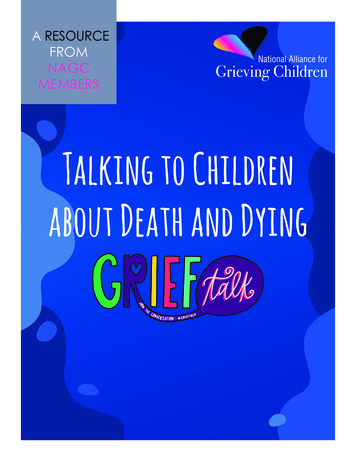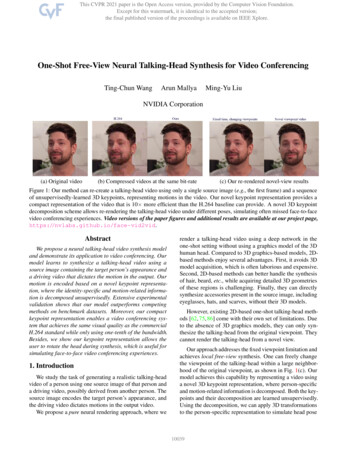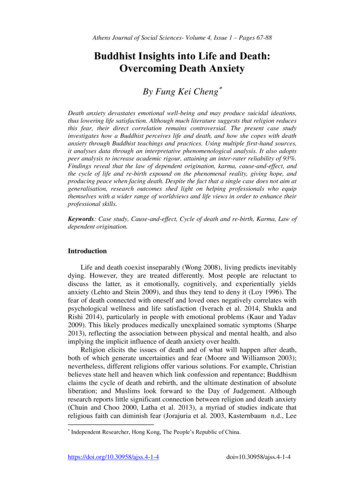
Transcription
A RESOURCEFROMNAGCMEMBERSTalking to Childrenabout Death and Dying
NAGC Grief Talk: Talking to Children About Death and DyingPage 2Grief Talk is an initiative of the NAGC launched in the summer of 2020 aimed atencouraging and supporting honest conversations around the topics of deathand grief. This initiative has produced the following resources:Talking to Children About Death and DyingTalking to a Child or Teen to Let them know Someone has DiedTalking about End of Life Memorials and RitualsTalking about Grieving as a FamilyVisit ChildrenGrieve.org to find these and other resources.Thank you to the following NAGC member organizations and individuals who contributed the contentfor this resource: (Listed alphabetically by last name. Highlighted names desigante the lead authors forthis guide.)Erin Brodbeck, LCSW, CT, Director of Grief Services, Sunset Funeral Homes (Champaign, IL)Karina Castillo, LCSW, Children’s Grief Support Program Manager, Community Hospice (Modesto, CA)Colleen Cherry, Founder, PlayWell Child Life Services(Laguna Niguel, CA)Alyssa Christensen, Grief Support Director, Mourning Hope Grief Center (Lincoln, Nebraska)Lauren Clarke, Program Manager, Bridges for End-of-Life (Charleston, SC)Lisa Conn, MSW, LISW-S, CAPT, Bereavement Counseling Professional, Ohio’s Hospice of Dayton (Dayton, OH)Pamela Gabbay, EdD, FT, Co-Founder, The Satori Group (Virginia Beach, VA)Peggy Galimberti, LMSW- Clinical, ACSW, Program Director, Ele’s Place (Ann Arbor, MI)Heather Gianatassio, Certified Child Life Specialist and Grief CounselorMelissa Lunardini, MA, MBA, CEO, Radical Grief, LLC (San Diego, CA)Valerie Myers MS, CT, CEO, Myers Compassionate Grief Services, LLC (Owings Mills, MD)Kaela O’Donnell, MSW, LCSWA, Program Therapist, KinderMourn (Charlotte, NC)Buffy Peters, Director, Hamilton’s Academy of Grief & Loss (Des Moines, Iowa)Irwin Sandler, Research Professor, Resilient Parenting for Bereaved Families (Phoenix, AZ)Corrie Sirota MSW, PSW, Clinical Social Worker & Psychotherapist, Author and Clinical Director of Myra’s KidsFoundation (Montreal, Quebec)Blair Stockton, MS, CCLS, CTP, CGCS, Compass Child and Teen Grief Services Coordinator, Four SeasonsHospice and Palliative Care (Flat Rock, NC)Copyright 2020 by National Alliance for Grieving Children. All rights reserved. You can quote, link to, repost or translate this article, in its entirety, as long as you credit the NAGC and add a working link back tothe NAGC’s website. www.ChildrenGrieve.org 2020 National Alliance for Grieving Children ChildrenGrieve.org
NAGC Grief Talk: Talking to Children About Death and DyingIntroductionIf you are raising or caring for achild or teen who has experienced adeath, you may wonder how to sharethis news with them. It is perfectlynatural to feel nervous or even fearfulof talking with a child about thisemotional topic! This resource wascreated to help you prepare for theseconversations.Setting the StageBefore initiating a conversationwith the child, there are somegeneral principles to consider. ThesePage 3include: who will deliver the news,as well as when, where, and how theconversation takes place.The person who shares the newsshould ideally be the person to whomthe child feels the closest. This is oftenthe parent/ parents, but not always.If the parent is the person who hasdied, a grandparent, aunt/ uncle, orother relative may be called upon totalk with the child. If it is possible andfeels right, another supportive adultwho is well known to the child mayalso be invited to be present.REMINDER: The person who shares the news should ideally be theperson to whom the child feels the closest 2020 National Alliance for Grieving Children ChildrenGrieve.org
NAGC Grief Talk: Talking to Children About Death and Dying‘‘Children often know morethan we realize. 2020 National Alliance for Grieving Children ChildrenGrieve.orgPage 4
NAGC Grief Talk: Talking to Children About Death and DyingPage 5Where and when the newsis shared can influencehow it is received. A calm,safe space where you willnot be interrupted is ideal.This may be the child’shome or another familiarplace where they feel safe.You may consider havingsome comfort items presentand available to the childperhaps a pet, stuffed animal,or special blanket.This person can be a resource andsupport for both the adult sharing thenews and the child.If you are the person who will betalking with the child, check in withyourself first- do you have support?Do you have the information youneed to share this news/ start theconversation? You are not expectedto have all of the answers, buthaving enough information to beginthe conversation is important. Youmay spend some time imagining howthe conversation might go, or evenchoose to practice with a friend orfamily member before talking withthe child.The timing of when toapproach this conversation isimportant to consider. Ideally, itis soon enough after the death toassure that they hear the news fromyou first, and not from a stranger orfrom social media. This allows you tocontrol the message that is sharedand build in time to support the child.You will want to be as preparedas you can to answer questionsand provide space for the child toshare and process their feelings.Depending on the child’s age anddevelopmental level, this may or maynot happen right away. Be awarethat the child may have additionalquestions or have a need to lead theconversation.Allow time for questions and processing feelings.It is best to avoid bedtime or just before school. 2020 National Alliance for Grieving Children ChildrenGrieve.org
NAGC Grief Talk: Talking to Children About Death and DyingPage 6Our instinct is often toprotect the child fromthe truth, particularlywith stigmatized (suicide,homicide, or drugoverdose) or graphicdeaths. However, childrenoften know more than werealize.Sharing information insmall bits at a time canbe very helpful. You donot need to share all of the detailsat once, as that can be upsettingor overwhelming, but what you doshare should be true.When you are with the child, youmay choose to sit close to themand perhaps gently place a handon their arm or back. Speak with acalm, compassionate tone and beprepared to be flexible to allow youto respond to the child.Start simply and plan to layer onadditional information over time.Provide the opportunity for thechild to repeat their understandingof what they heard you say, thenrestate or clarify if needed. Themost important thing you can do forthe child is to be present, kind, andcompassionate.Expectations Following theConversationSharing the news of the person’sdeath is only the beginning of theconversation. As indicated above,the child may not be ready or ableto ask questions or respond rightaway to the news of the death.Children respond to death verydifferently than adults.Some children, especially youngerchildren, may not respond as wemight expect. They may not cry oreven seem to understand what youhave shared. Children often needto go away and be by themselvesRemember, this is not a one-time conversation.You do not need to share all of the details at once. Provideopportunities for small conversations over time. 2020 National Alliance for Grieving Children ChildrenGrieve.org
‘‘NAGC Grief Talk: Talking to Children About Death and DyingPage 7The most importantthing you can dofor the child is to bepresent, kind, andcompassionate.or play. A child choosing to playdoes not indicate that they did notunderstand or care about the death.In fact, play can be a powerful wayfor children to process the news.Provide opportunities for smallconversations over time. Invite thechild to talk with you anytime andencourage their questions. If thereare multiple children of differentages and different needs, they mayeach respond differently. Provideopportunities for each child to followup one on one. This will allow themeach some special time to talk, askquestions, and begin to process thenews.The initial conversation aboutthe death is the start of a lifelongconversation. You should beprepared to revisit the topic overtime as the child grows anddevelops. Plan to check in with thechild regularly to support them innavigating the difficult times ahead.Children respond to death very differently than adults.Play can be a powerful way for children to process the news. 2020 National Alliance for Grieving Children ChildrenGrieve.org
NAGC Grief Talk: Talking to Children About Death and DyingPage 8Understanding Very Young Children(Birth - 5yrs)Normative Tasks of Development (What very young children commonly do.) From birth to five years, old children move through several important tasks.During the first year of life, infants must learn to trust the adults in their lives – develop secure attachmentToddlers (1–3 years) begin to explore their world and learn that they can be independent and control their actions.Pre-schoolers are initiators, focusing on themselves and what they want andneed.Understanding and Response to Death Awareness of death is directly influenced and limited by young children’s abilityto understand their world.Death is viewed as the absence of a parent or caregiver.Children may be preoccupied with who will take care of them.Children may see themselves as responsible in some way, for a death, and theydo not yet recognize time and irreversibility of death. 2020 National Alliance for Grieving Children ChildrenGrieve.org
NAGC Grief Talk: Talking to Children About Death and DyingPage 9Sources of supportAs parents or caregivers, you are the primary source of security for your children—your continued reassurance about your presence and support is crucial. Extendedfamily such as grandparents and others may also provide important support, andyou can discuss with them how they can be helpful.What They Need from Parents or Caregivers Be a good listener. In all of yourcommunication, be sure to listento what your child is experiencingand feeling and show that youunderstand. Establish and maintain routines.Offer reassurance about thepredictability of events and familysecurity and routines. Recognize that very young child donot understand death as adults do.When appropriate, gently explainwhat is happening. You can providegentle repeating of the facts,knowing that time will help their childunderstand their loss. Respond truthfully. When askedquestions, respond truthfully aboutdeath according to your own beliefsystem. Model healthy grieving. When a childsees you being sad or expressessadness, or other emotion, explainthat you too are sad or experiencesimilar emotions; sadness is one waypeople show they miss someone whohas died. Reassure children they are safe andcared for. Describe and reassure thatyour family will experience a “newreality” and new routines and thatthey will be safe and cared for. Oneway to do this is to establish familylife routines and special times to betogether. Allow and encourage children toplay and have fun when they wantto. Talk about the person who died. Givechildren opportunities to learn andshare about their person. Don’t beafraid to talk about the person thatdied. Encourage expressive activities. Youmight ask preschool children to drawa picture showing a memory of theirperson, follow up by asking them totell you about the picture. Include the child in the family rituals& mourning as appropriate for yourculture. Be assured regressive behavioris natural. When a child showsregressive behavior, show patienceand understanding. 2020 National Alliance for Grieving Children ChildrenGrieve.org
NAGC Grief Talk: Talking to Children About Death and DyingPage 10Understanding School -Age Children(6yrs-12yrs)Normative Tasks of Development(What children commonly do.)During this time, the critical task is developing competency and building a senseof pride and accomplishment in theirschoolwork, sports, social activities, andfamily life. Understanding and Response to Death Awareness of death is influenced andlimited by the school-agers’ ability tothink about their world.Many emotions and grief can be explained and understood.Explain that grief is a combinationof reactions that one can have aftersomeone has died—thinking aboutthe person, feelings of sadness or anger, physical reactions such astiredness, or an upset stomach.These reactions can come or go.Anger can be attributed to a numberof causes. It may not be the angerchildren feel because an importantperson has died, but the anger thatresults when no one listens or talks tothem or includes them in activities.Don’t assume what prompts feelings,ask!Children may not see themselves asresponsible for a death and recognize that death is irreversible.Children will be able to appreciatehow the loss of an important person in their lives will affect themover time, weeks, or months but notthe long term, life-long impact of adeath. 2020 National Alliance for Grieving Children ChildrenGrieve.org
NAGC Grief Talk: Talking to Children About Death and DyingPage 11Sources of supportAlthough school and outside of family worlds are increasingly important, parentsand family are still the school agers’ primary source of support. Use outside resources as you feel you need to and be sure that your child is receiving the supportthey need from these resources.What They Need from Parents or Caregivers Be a good listener. Encourage theirexpression of what they are feeling,their concerns about their parent orcaregiver’s health, financial issues,etc. They also provide acceptanceand reassurance as needed.Respond to children’s need forinformation about the death –often the details – allowing themto build a sense of control. Theymay have a matter of fact reactionrather than an emotional one to thecircumstances – what happened,when, where, more detail-oriented.Give factual answers to questions asbest you can.Recognize that children do not wantto be different from other childrenbecause of the death. So provide thesupport they need to continue theirongoing activities with their peers.Find grief support groups that areavailable.Accept your children’s opendiscussions about the deceased:talking or joining with them, magicalthinking, and concerns about theirparent or caregiver’s health orfinancial problems. Appreciate that your child cansimultaneously hold contradictoryemotions – sad about the death yethappy to take a special vacation. Address how the death has and willaffect their lives . . . “who will helpme with my homework?” Childrenneed the reassurance of continuityin their world. Help your children find the rightbalance between holding backemotions and the need forremembrance. You can involvethem in creating family rituals ofremembrance. Help them deal with separationanxiety by fully preparing them forany future anticipated separations. Create opportunities for childrento remember and express theirgrief and let the child choose howto be involved in the mourning andremembering rituals. Establish ongoing family routines,including positive times that youspend together as a family. 2020 National Alliance for Grieving Children ChildrenGrieve.org
NAGC Grief Talk: Talking to Children About Death and DyingPage 12Understanding Teenage Children(13yrs )Normative Tasks of Development(What teenagers commonly do.)The adolescent years are the testingground for the essential transitionfrom child to adult. The critical taskof adolescence is for teens to find outwho they are and how they fit into theirfamilies, peer group, and the globalcommunity. There is an increasinginfluence of peers, school, and otheradults in the community on theirdevelopment, although the influence offamily is still important.Understanding and Response to Death The teen’s awareness andunderstanding of death is similar tothat of adults. They can incorporate multiple causes and consequencesof a death.Many complex emotions and griefcan be explained and understood.Support them in understanding thatgrief is a combination of reactionsthat one can have after someonehas died—thoughts about the person,feelings like sadness or anger,physical reactions such as tiredness,or an upset stomach. They can alsoexperience more subtle emotions orregret, ambivalence, or relief. Thesereactions can come or go.Anger can be attributed to a numberof causes. It may not be the angera teen feels because an importantperson has died but the anger thathe or she feels when no one listens ortalks to them, or has eliminated them 2020 National Alliance for Grieving Children ChildrenGrieve.org
NAGC Grief Talk: Talking to Children About Death and Dying Page 13from activities. Don’t assumewhat prompts feelings, ask!Teens do not see themselvesas responsible for a death butare apt to analyze informationto determine who or what isresponsible.Sources of supportAlthough peers and other adults become increasingly important, parents and caregivers continue to be critical sources of information and supportWhat They Need from Parents or Caregivers Be available to listen and talk.Parents and caregivers can engagein detailed narratives of the deathand related events. Encourage involvement in positivefamily activities. Although they areincreasingly involved with peersand outside activities, your family’scontinuity as a safe place wherepeople care about each other isvery important to them. Be aware of the intensity of a teen’sgrief experience. They may expressmood swings. Expect & acceptmood swings. Allow hidden feelingsunless there is a risk of harm. Offer specific opportunities forexpression of feelings and ofremembrance through writing,art,music, sports, etc. Encourage their participation inpeer support groups if desired. Support their unique identitydevelopment and independence.Acknowledging their preferenceof spending more time withfriends– balanced with continuedinvolvement in family activities andfamily bereavement remembrances.Avoid escalation of conflict as theyexpress their independent identity. Consistently set appropriate limits.Adolescents need these limits,although they may protest againstthem. Avoid having them take on toomuch family responsibility if it is atthe expense of their independentdevelopment. Encourage stress reduction. Avoidgetting them involved in solvingstressful situations beyond theirability to control, such as conflictsbetween adult family members orfinancial problems. 2020 National Alliance for Grieving Children ChildrenGrieve.org
NAGC Grief Talk: Talking to Children About Death and DyingPage 14Talking to Childrenwith Special Needsabout Death andDyingCommunication with special needschildren is as important as speakingwith any child. As the parent of aspecial needs child, here are somepoints that guide your conversation.Be honest.Honesty is the foundation of a trustingrelationship between the caregiver/parent and child.Use Appropriate WordsTry to use appropriate words, suchas “died” instead of “left” or “passedaway”.It is ok to use the word “sad”depending on the children’srelationship with the deceased.Answer QuestionsBe prepared that children may askthe same questions several times.Allow ExpressionAllow children to express their griefin whatever way makes sense forthem. They may just want to ignore itand play. Find ways in which to helpchildren grieve in appropriate ways.Non-verbal children may expresstheir grief through acting out orself-injurious behaviors. Providethem with activities and copingmechanisms to help them expresstheir grief. For example, have themsqueeze a stress ball or blow somebubbles. 2020 National Alliance for Grieving Children ChildrenGrieve.org
NAGC Grief Talk: Talking to Children About Death and DyingExplain Rituals and What to ExpectExplain rituals in a more detailedmanner. Step-by-step instructionsabout what happens during amemorial or remembrance servicecan be helpful. For example, “First,we are going to drive to the funeralhome. When we get there, people insuits will help us park the car. Theymight even put a flag on the top.”Page 15Do Remembrance ActivitiesSome examples of remembranceactivities to do with children are:wearing a piece of jewelry or clothingthat belonged to the deceased;listening to the deceased favoritemusic; looking at a scrapbook of thedeceased; and making a memorybox in which children can add theirown memories.Practice the End of Life RitualMake a practice drive or visit to theplace where the deceased will beremembered or buried in advance ofservices.Some children may have difficultywith emotional cues. Explain thatthey may see more crying, hugging,or sadness. Having a picture chartor symbol stix available can assistchildren with picking up emotionalsignals from others and respondappropriatelyUse BooksUse books to help explain death tochildren or as a way to help themcope with the loss.It might be helpful to have a checklistto help you remember the steps inthe process. Even a picture book canbe helpful. 2020 National Alliance for Grieving Children ChildrenGrieve.org
NAGC Grief Talk: Talking to Children About Death and Dying10 Key Points to Remember WhenTalking to Children about Deathand DyingGrief is individualChildren usually don’t tell youthey are grieving by what theysay and do. No two childrengrieve the exact same way,but there are typical reactionsthat can help you know a child isgrieving.1Use Simple, Clear AgeAppropriate LanguageThe caregiver/parentshould explain the death ina compassionate mannerusing age appropriate short, simpleexplanations in language childrencan understand.2It is important to use the rightwords to talk about the death, like“Mom died from cancer.” Avoideuphemisms such as passed away,went to sleep, as they can confusethe children. This is key so thatchildren do not associate the deathwith anything other than the reality ofhow it occurred.3Children want to be told thetruth about the deathIt can be difficult to explaina stigmatized death toPage 16a child, for example, death from asuicide or drug related death.Our instinct is to protect the childfrom heart breaking situations,although it might be morecomfortable for us to avoidthese conversations, they arevery important for the child’sunderstanding.Be honestHonesty is the foundationof a trusting relationshipbetween the caregiver/parent and child. Lyingto children about the circumstancesof death can lead to bitterness andmistrust when children learn the truth.Let the child’s questions guide whatyou share. Speak openly and honestlyabout the death. It is ok not to knowall the answers.4Take Time to Prepare forDifficult ConversationsTake some deep breathsand give yourselftime to collect yourthoughts. Think of thisinitial conversation as laying thegroundwork, allowing the child to askquestions and exploring what thechild is thinking. It is not the time toshare all available information. Focuson ensuring they understand whatwas said and explain that the deathwas no one’s fault.5 2020 National Alliance for Grieving Children ChildrenGrieve.org
NAGC Grief Talk: Talking to Children About Death and DyingAccept this is an OngoingConversationYounger children mightneed to be told many timesas they might ask over andover again how the person died.6ListenWhen a child is grieving,people can be quick tooffer advice, give opinionsand make judgments.What’s most helpful is to listenwithout judging, interpreting, orevaluating.7Listening is a 2 way conversation.Sometimes the best response is torepeat what you hear them say—called “reflecting”—so that they knowthey have been heard. Listening tochildren, without jumping in to try tofix anything or make it better, is one ofthe best ways to help them feel heardand supported.Page 17Allow and ValidateEmotional ExpressionIt is important for grievingchildren to be able toexpress their grief andhave it validated. Validation of griefreactions occurs when adults orpeers in a child’s life acknowledgewhat the child is feeling and allowsthe child the space needed to expresshis/her grief in the way that feelsmost natural to them as long as theyare not hurting themselves or others.9Grief is long lastingGrief is not anexperience that children“get over” or “move on”from after a few weeksor months. Grief doesnot have a timeline, and it changesover the course of someone’s life. It isOK for children to continue to grievethe loss as they grow and develop.10Model Healthy GrievingChildren look to theircaregiver/parent as arole model for how peoplegrieve. Share your feelingswith them as long as they are relievedof the task of trying to “fix it.”8 2020 National Alliance for Grieving Children ChildrenGrieve.org
NAGC Grief Talk: Talking to Children About Death and DyingPage 18When to seek additional supportAfter a death, it is important to monitor changesin frequency, intensity, and duration of familymembers’ behaviors. Noticeable changes mayrequire additional support from an experienced,trained professional.Below are some examples of changes to look for: Inability to go to work or schoolDifficulties in relationshipsSleep problems or nightmaresDisproportionate anger or irritabilityIncreased health issuesFeelings of hopelessnessSocial withdrawalSelf-harm, suicidal thoughts or suicidal ideationThese changes can have an impact on the griever and the other familymembers. When changes in behavior go unnoticed and unaddressed, thiscan create an imbalance within the family. Addressing these changes willhelp create a supportive and safe environment for each member of thefamily.Sometimes members in a family may want to connect with others foradditional support. Connecting family members with peer support groups,camps, conferences, or even another person with a similar loss can helpprovide an added layer of support. These outside connections provide thegriever with an opportunity to learn new perspectives on grief, coping, andhealing.Connecting with others allows the griever to share their story, understand thatthey are not alone, validate and normalize their experience. It is important toembrace a family members’ readiness, as well as the type of support needed.Needs may vary among family members throughout their grief journey.You can find additional support in your area by visiting childrengrieve.org/find-support. 2020 National Alliance for Grieving Children ChildrenGrieve.org
Learn more at www.ChildrenGrieve.org 2020 National Alliance for Grieving Children ChildrenGrieve.org
NAGC Grief Talk: Talking to Children About Death and Dying National Alliance for rieving Children Childrenrieve.org Page 5 Allow time for questions and processing feelings. It is best to avoid bedtime or just before school. This person can be a resource and support for both the adult sharing the news and the child. If you are the person who will be










